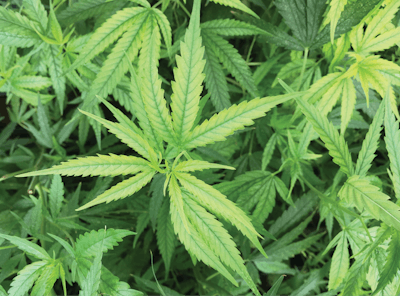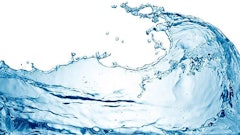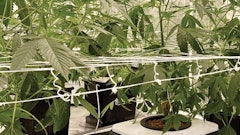

We’re typically cautious about what’s in our drinking water, but how often do we think about the water our plants are consuming? The pH and alkalinity of your irrigation water can have a dramatic effect on the substrate pH and, consequently, plant production. That’s why testing your irrigation water is important.
pH is a measurement of the relative hydrogen (H+) ion concentration in the water. By itself, it has only a minimal influence on your substrate pH. Alkalinity levels, on the other hand, can quickly influence the substrate environment and nutrient availability. Alkalinity is a measurement of the carbonate concentration in the irrigation water. The relative concentration of carbonate species—carbonates (CO32-), bicarbonates (HCO3-), and carbonic acid (H2CO3)—is the main buffering system controlling irrigation water pH and substrate solution pH. If the irrigation water contains a high concentration of carbonates and bicarbonates, the substrate solution pH can rise to undesirable levels for cannabis production.
Bicarbonates are not thought to be directly toxic, but they will interfere with essential element root uptake and increase the substrate solution pH. Iron deficiency, identified by yellowing or interveinal chlorosis of newly expanding and developing leaves, is the primary problem for plants growing in a high pH substrate (Fig. 1). Iron deficiency is more acute for crops being grown in a small volume of root substrate or those grown for a longer production time, which allows a gradual rise in substrate pH.
Alkalinity Levels: Why They Matter
High alkalinity levels in irrigation water can limit plant growth and cause economic losses for producers of container-grown cannabis crops. High alkalinity can occur in coastal areas or at locations over limestone bedrock. Much of the well water in the Midwest and Great Plains of the U.S., southern Ontario and the prairie provinces of Canada contain excessively high levels of alkalinity. Testing your water is the first step in determining a management plan.
Considerations for Alkalinity Testing
The level of alkalinity in irrigation water can vary with well location, well depth and time of the year. A standard water analysis usually includes pH, electrical conductivity and alkalinity. Cannabis growers may also want to test for macro-nutrients, including nitrogen (N), phosphorus (P), potassium (K), calcium (Ca), magnesium (Mg) and sulfur (S), and micronutrients boron (B), chloride (Cl), copper (Cu), iron (Fe), manganese (Mn), molybdenum (Mo), and zinc (Zn) in their water. Water tests are recommended for each well and should be done annually. Because plugs contain a small volume of substrate, cannabis clone producers should consider monthly water tests while they are starting to monitor the water quality variations over the course of the year.

Taking an Alkalinity Sample
Obtaining a water sample for alkalinity testing is quick and simple. Here’s how:
Sampling Procedure
- Allow the water to run for five minutes to clear the line, making sure the sample is clear of any fertilizer solution.
- Rinse a clean, plastic 16-ounce container two to three times with the water to be tested.
- Fill the container completely and cap tightly.
- Label the bottle with your name, address and type of analysis requested.
- Mail the sample so it arrives at the lab within 24 hours.
Alkalinity Testing
A number of commercial labs conduct water analysis for alkalinity and micronutrients. Make sure you send your sample into a commercial lab that will be able to provide acid injection recommendations. For analysis, check with your local extension personnel. Some states have free testing options, and some labs or states will only run a portion of the tests you may need.
Methods to Neutralize Alkalinity
Every cannabis operation varies in water quality, root substrate type, fertilizer type (acidic or basic), watering practices, container size and length of time a crop is grown. Therefore, because alkalinity is the main component influencing the production system, it should be neutralized first before you determine and implement a fertilizer strategy.
Growers can use a few methods to overcome high alkalinity in their irrigation water: acid addition, fertilizer modification or utilizing pond water for irrigation. The methods or combination of methods used vary depending on the operation. They include:
1. Acid Injection
Acid is injected into the irrigation water to neutralize the alkalinity. The amount of acid needed depends on the starting pH and alkalinity level of your irrigation water and the target endpoint alkalinity level desired. In general, a target endpoint alkalinity of about 2 milliequivalent (meq) [122 ppm bicarbonate (HCO3-)] is recommend for most greenhouse-grown crops, including cannabis. (This also applies to container-grown cannabis indoors.) This should result in an endpoint water pH of 6.0 to 6.2. This target endpoint allows for seasonal variations of alkalinity that naturally occur in wells and allows for errors in measuring acids. Operations that produce clone plugs and are willing to monitor their alkalinity level weekly may desire to neutralize to 1 meq of alkalinity (which will result in a water pH near 5.7) to have greater control of their substrate pH.
The common acids used for alkalinity control are: phosphoric (H3PO4) (75% and 85%), sulfuric (H2SO4) (35% and 93%), or nitric (HNO3) (61.4% and 67%). Each acid supplies beneficial nutrients to the plants. For instance, one ounce of each acid added per 1,000 gallons of water would supply: 2.92 ppm P with 75% phosphoric acid, 1.14 ppm S with 35% sulfuric acid, or 1.47 ppm N with 61.4% nitric acid. All acids are hazardous because of their characteristics, but some are more potent than others. Phosphoric acid, for example, is relatively safer than sulfuric, which is safer than nitric. Therefore, growers should wear protective clothing when handling acids. Citric acid can also be used but is the least economical.
Remember to always add acid to water! Do not add water to a concentrated acid (which could cause it to splatter up and result in severe burns). This means if you have to mix a tank, first fill up the tank with water and then add your concentrated acid. This will also ensure that you have a homogeneous mixture.
Most operations use sulfuric acid. It is the least expensive, moderately safe and provides adequate levels of sulfur. The simplest type to use is battery acid, which is 35% sulfuric acid. Phosphoric acid is suited for operations needing to neutralize up to 1 meq of alkalinity. When higher amounts of alkalinity must be neutralized, the amount of phosphorus (P) provided far exceeds the requirements of the plants. High levels of P can result in excessive plant stretching, especially for clone plugs.

(Some commercial floriculture growers use phosphoric acid to provide plants with sufficient levels of P and neutralize the remaining alkalinity with sulfuric or nitric acid.) Growers sometimes select nitric acid because it supplies N and allows them to decrease the amount of N fertilizer applied.
After adding acid, retest the water after one day and two to three weeks later to double check your water pH and alkalinity levels. Because cannabis is a bioaccumulator, it would be ideal to test the acid you use to ensure that it does not contain heavy metals.
2. Acidic Fertilizers
All fertilizers are labeled with their level of acidity or basicity, which is expressed in pounds of calcium carbonate equivalent per ton (an agricultural term that measures the basic or acidic effects of a fertilizer on the soil pH). Acidic fertilizers offer another option to neutralize alkalinity and lower the root substrate pH. The acidifying potential of acidic fertilizers is mainly due to the ammoniacal and urea forms of nitrogen. High levels of ammoniacal-nitrogen can lead to ammonia toxicity in some crops (identified as yellowing and possible curling of the upper leaves, which may progress to a marginal necrosis).
Ammonia toxicity is more likely to occur during the winter months (cool substrate and air temperatures and overcast conditions). In addition, ammoniacal and urea forms of nitrogen promote leaf expansion. Too high of a percentage of nitrogen in these forms can result in excessive plant growth. Greenhouse growers prefer fertilizers with more than 80% of the nitrogen in the nitrate form to avoid excessive growth rates.
The general recommendation from North Carolina State University for continuous fertilization of greenhouse-grown floriculture species is that ammoniacal-nitrogen (plus urea) should supply less than 33% of the total nitrogen (with the remainder being nitrate-nitrogen). This also applies to cannabis grown indoors. When an acidic fertilizer is used to counteract alkalinity, ammoniacal-nitrogen levels can be as high as 50%. Acidic fertilizers with ammoniacal-nitrogen levels more than 50% are only recommended as short-term corrective measures.
3. Pond/Surface Water
Pond water is an excellent source for irrigating plants. Pond water does not contain excessive levels of alkalinity nor other nutrients. Levels of calcium and magnesium in pond water are usually low, and supplemental Ca and Mg applications may be required. Protecting the pond from contamination is a must for growers. Herbicide runoff is a concern, and water from surrounding farm fields must not drain into the pond. Filtration and algae control must be implemented before using pond water.
Stay on target
Regardless of the method selected, alkalinity neutralization is required for operations that have well water alkalinity levels greater than 2 meq [122 ppm bicarbonate (HCO3-)]. Growers will need to select a neutralization method that best suits their operation. It is best if you conduct routine analysis of your root substrate to monitor your pH and nutrient levels and to ensure that your fertility and alkalinity neutralization programs are on target.
























